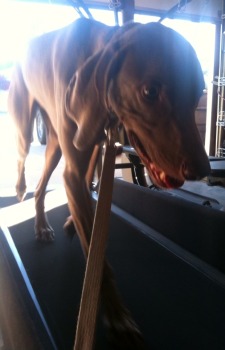Many symptoms of anxiety or fear disorders are thought to be learned and research on fear conditioning, a method of learning to fear a particular stimulus, shows that individuals diagnosed with anxiety disorders are quick to learn to fear a stimulus but have a difficult time getting rid of that fear without replacing the stimulus with physical actions or steps to change the learned habit.
As fear becomes an automatic reaction in humans, our dogs are picking up the behavior as well. Dogs do learn and think in pictures. With fear being the base of many of our human reactions it is no wonder that many of my calls for help with dog behavior training revolve around fear aggression.
Movement Dissipates Fear
Ever get in an argument where you feel defensive and before you know it you don’t know where the argument started? If most of these arguments were analyzed as to why the initial reaction occurs, it would come down to fear. Fear of something that’s happened before. Fear of the unknown. Fear of the same thing every day. Fear of not ever going and doing what your really want to do. It’s usually not even about what is happening right now in this moment. Instead the reaction seems to built around what could happen.
And because our dogs do in fact emulate or mimic our behavior, the reaction of fear is becoming an ever increasing issue.
 Whether that fear is coming straight down the leash from the human or initiates from the dog’s end of the leash, changing that behavior doesn’t happen without some kind of movement. Fear, stress and anxiety are difficult to move away from, but the one thing that has made a difference in those willing to make a change: Exercise.
Whether that fear is coming straight down the leash from the human or initiates from the dog’s end of the leash, changing that behavior doesn’t happen without some kind of movement. Fear, stress and anxiety are difficult to move away from, but the one thing that has made a difference in those willing to make a change: Exercise.
Physical Activity Can Soften Anxiety, Depression & Fear
This is true for people and for dogs. Exercise is a reliever for stress, depression and anxiety. Dogs come from a place of roaming, hunting, exercise and play and our urban lives have limited those activities and with it has come more fear aggression.
Breaking the cycle of habit is the important step that needs to happen when it comes to fear aggression, especially when it pertains to dogs. More exercise softens reactions. Getting more exercise when dogs have reactions to other dogs is difficult because it becomes a really scary thing for us humans to deal with…. dog lunging, loud barks, growls, raised hair and the reaction of others make it overwhelming to get out and get the exercise a dog with fear aggression desperately needs to ever get over the behavior.
Treadmill Training for Fear Aggression | Bridge to the Great Outdoors
One could start this whole thought process out with the idea of “A tired dog is a good dog”. Same idea as children. Get a regular exercise and unruly behavior is much less likely.
Though our health care system may not profit from the idea of exercise, it should be the new miracle drug. As a professional trainer… the same is true for dogs. Many lessons later people are not getting the result they’d like with just traditional obedience training. Feed all the treats you want to, not addressing the fear with movement isn’t helping either. Add the appropriate amount of exercise along with mental stimulation of knowing how to do the basics like “come” “sit” “stay” and “let’s go” and you have a winning combination.
A treadmill training program for a dog with fear aggression I have found to be the fastest way to begin to enjoy the great outdoors with your dog again. Walk the trails, beaches and neighborhoods without such trepidation. Take the edge off of fear and move to having more fun is what comes of a treadmill training program for fear aggression.
Rowdy the Weimaraner is one of those dogs. When he started his treadmill training program he was a dog that …. well… read what his owner writes about him…. it’s a great story… and one that many many other dogs who suffer with fear aggression can benefit from. Movement and exercise from the treadmill to the joy of doing things outdoors with your dog are the benefits worth the smile your dog can have with a much more balanced lifestyle.
What Happened to Rowdy the Weimaraner and His Fear Aggression Toward Dogs
My 3 year old dog Rowdy had become increasingly out of control. He was barking, biting, and likely to run away or jump on someone when we opened the front door.
Because he was aggressive toward other dogs I couldn’t even walk him so he was trapped in the house with no outlet for his energy.
I was losing total control, fearful I may have to give him up to a friend with a home in the country I decided to try some training.A search connected me to Jt. I had an instant comfort level with her ability to respond to Rowdy and his personality. We signed up for the “Treadmill Training – Fear Aggression for a New Lifestyle Program” and now I come home to my “real” dog.
After Treadmill training Rowdy can now go anywhere with me and ignore other dogs,
we can even sit outside at a restaurant and relax while he is “parked” next to me.
After training with Jt’s Treadmill Training, Rowdy is now much calmer, no more nervous energy
around the house, he even has good manners when the doorbell rings!Now everyone enjoys my sweet and beautiful dog.
Thanks Jt!

This is interesting and makes a lot of sense. I myself use physical exercise to battle my own anxiety related issues and it is the only thing that’s keeping my head above water.
Thanks for the comment Jana. I use exercise as well as my form of calm. It keeps me focused and not looking for some wild thing to pull me off track. And my dogs do well by it too! 🙂
I fully agree that exercise helps animals and children with any anxiety. I’d also that it is really useful for us adults as well :). Nice article.